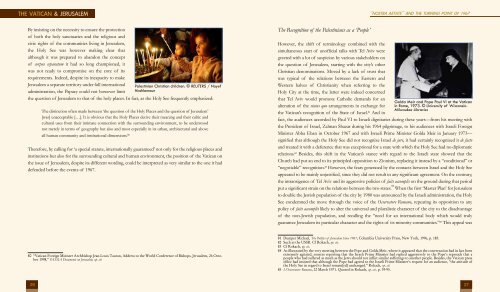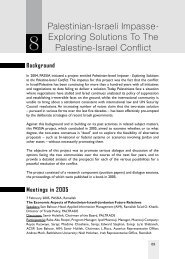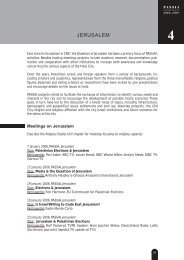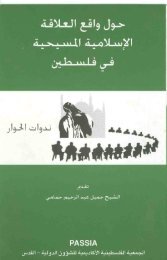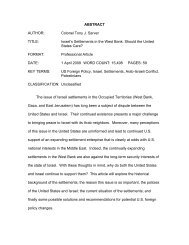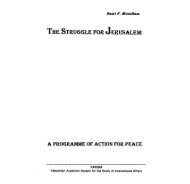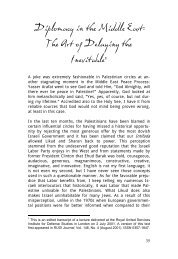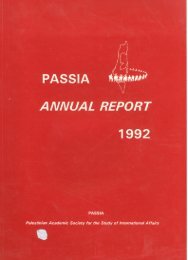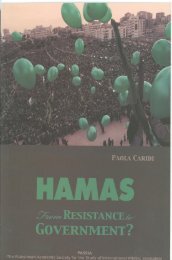The VaTican & Jerusalem - PASSIA Online Store
The VaTican & Jerusalem - PASSIA Online Store
The VaTican & Jerusalem - PASSIA Online Store
You also want an ePaper? Increase the reach of your titles
YUMPU automatically turns print PDFs into web optimized ePapers that Google loves.
<strong>The</strong> Vatican & <strong>Jerusalem</strong>By insisting on the necessity to ensure the protectionof both the holy sanctuaries and the religious andcivic rights of the communities living in <strong>Jerusalem</strong>,the Holy See was however making clear thatalthough it was prepared to abandon the conceptof corpus separatum it had so long championed, itwas not ready to compromise on the core of itsrequirements. Indeed, despite its incapacity to make<strong>Jerusalem</strong> a separate territory under full internationaladministration, the Papacy could not however limitPalestinian Christian children. © REUTERS / NayefHashlamounthe question of <strong>Jerusalem</strong> to that of the holy places. In fact, as the Holy See frequently emphasized:<strong>The</strong> distinction often made between ‘the question of the Holy Places and the question of <strong>Jerusalem</strong>’[was] unacceptable […]. It is obvious that the Holy Places derive their meaning and their cultic andcultural uses from their intimate connection with the surrounding environment, to be understoodnot merely in terms of geography but also and most especially in its urban, architectural and aboveall human community and institutional dimensions. 80<strong>The</strong>refore, by calling for ‘a special statute, internationally guaranteed’ not only for the religious places andinstitutions but also for the surrounding cultural and human environment, the position of the Vatican onthe issue of <strong>Jerusalem</strong>, despite its different wording, could be interpreted as very similar to the one it haddefended before the events of 1967.<strong>The</strong> Recognition of the Palestinians as a ‘People’However, the shift of terminology combined with thesimultaneous start of unofficial talks with Tel Aviv weregreeted with a lot of suspicion by various stakeholders onthe question of <strong>Jerusalem</strong>, starting with the city’s otherChristian denominations. Moved by a lack of trust thatwas typical of the relations between the Eastern andWestern halves of Christianity when referring to theHoly City at the time, the latter were indeed concernedthat Tel Aviv would promote Catholic demands for analteration of the status quo arrangements in exchange forthe Vatican’s recognition of the State of Israel. 81 And in“Nostra Aetate”and the Turning Point of 1967Golda Meir and Pope Paul VI at the Vaticanin Rome, 1973. © University of Wisconsin-Milwaukee Librariesfact, the audiences accorded by Paul VI to Israeli dignitaries during these years—from his meeting withthe President of Israel, Zalman Shazar during his 1964 pilgrimage, to his audiences with Israeli ForeignMinister Abba Eban in October 1967 and with Israeli Prime Minister Golda Meir in January 1973—signified that although the Holy See did not recognize Israel de jure, it had certainly recognized it de factoand treated it with a deference that was exceptional for a state with which the Holy See had no diplomaticrelations. 82 Besides, this shift in the Vatican’s stance with regard to the Israeli state showed that theChurch had put an end to its principled opposition to Zionism, replacing it instead by a “conditional” or“negotiable” recognition. 83 However, the fears generated by the contacts between Israel and the Holy Seeappeared to be mainly unjustified, since they did not result in any significant agreement. On the contrary,the intransigence of Tel Aviv and its aggressive policies of faits accomplis on the ground during that periodput a significant strain on the relations between the two states. 84 When the first ‘Master Plan’ for <strong>Jerusalem</strong>to double the Jewish population of the city by 1980 was announced by the Israeli administration, the HolySee condemned the move through the voice of the Osservatore Romano, repeating its opposition to anypolicy of faits accomplis likely to alter the universal and pluralistic character of the city to the disadvantageof the non-Jewish population, and recalling the “need for an international body which would trulyguarantee <strong>Jerusalem</strong> its particular character and the rights of its minority communities.” 85 This appeal was80 “Vatican Foreign Minister Archbishop Jean-Louis Tauran, Address to the World Conference of Bishops, <strong>Jerusalem</strong>, 26 October1998,” <strong>PASSIA</strong> Documents on <strong>Jerusalem</strong>, op. cit.81 Dumper Michael, <strong>The</strong> Politics of <strong>Jerusalem</strong> Since 1967, Columbia University Press, New York, 1996, p. 185.82 Such as the USSR. Cf Rokach, op. cit.83 Cf Rokach, op. cit.84 As illustrated by the very meeting between the Pope and Golda Meir, where it appeared that the conversation had in fact beenextremely agitated, sources reporting that the Israeli Prime Minister had replied aggressively to the Pope’s reproach that apeople who had suffered as much as the Jews should not inflict similar sufferings to another people. Besides, the Vatican pressoffice had insisted that although the Pope had agreed to the Israeli Prime Minister’s request for an audience, “the attitude ofthe Holy See in regard to Israel remain[ed] unchanged.” Rokach, op. cit.85 L’Osservatore Romano, 22 March 1971. Quoted in Rokach, op. cit., p. 93-95.26 27


